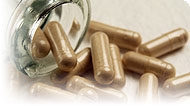Gluten Free
What does following a gluten-free diet mean? That you're embarking on an easy diet with a wide range of health-promoting effects. Instead of dwelling on what you’re giving up, consider that you’re going to enjoy a whole new world of delicious food options to meet your special dietary needs. You’ll be eating seasonally, choosing more fresh fruits and vegetables, focusing on meats, seafood, poultry, legumes, lentils, corn, and rice, and discovering fascinating ancient grains such as quinoa, amaranth, and millet. You’ll be able to eat potatoes, eggs, most cheeses, even chocolate (!)—and enjoy them without guilt because you’ll be taking good care of your body. In fact, you’ll probably end up eating—and feeling—better than ever!
Visit this page for more information about living Gluten Free
---
We carry a large variety of gluten free items, the brands listed below represent just some of the offerings we carry















More Diets
Progesterone

How to Use It
The proper amount of progesterone for a woman should be determined in consultation with a doctor. Some research with the natural, oral form of progesterone has used 200 mg per day.1 Progesterone is used in much lower amounts—such as 20–70 mg per day—by most doctors who prescribe topical natural progesterone. However, the ability of skin-applied progesterone to achieve effective levels in the body is the source of considerable debate.2 Although progesterone is a natural substance, oral progesterone supplements are available by prescription only. High-dose topical progesterone cream is also treated like a drug and requires a prescription. A few creams containing lower amounts of progesterone are sold without prescription.
Where to Find It
Progesterone is produced in the female body in the ovaries. Progesterone production is high during the luteal phase (second portion) of the menstrual cycle and low during the follicular phase (first portion), as well as being low before puberty and after menopause.
Supplemental sources of progesterone are available in oral and cream forms, as well as lozenges, suppositories, and injectable forms. “Natural” progesterone refers to the molecule that is identical in chemical structure to the progesterone produced in the body, even if the molecule is synthesized in a laboratory.
Progestins are found in oral contraceptive pills and are used in conventional hormone replacement therapy.
Wild yam contains precursors to progesterone (such as diosgenin) that can be converted through a chemical process in the laboratory into progesterone—the exact same molecule made in the human body. However, contrary to popular claims, the diosgenin in wild yams cannot be converted into progesterone in the body.3, 4 Women who require progesterone should consult their physician and not rely on wild yam or other herbs.
Pregnenolone, another hormone produced by the body, is converted by the body into progesterone. However, it is not clear what effect supplementing with pregnenolone will have on progesterone production in the body.
Possible Deficiencies
Postmenopausal women have reduced production of progesterone. While this “deficiency” is normal, progesterone, including the natural forms of progesterone, has been found to relieve menopausal symptoms when used in combination with estrogen replacement therapy.5
Copyright © 2025 TraceGains, Inc. All rights reserved.
Learn more about TraceGains, the company.
The information presented by TraceGains is for informational purposes only. It is based on scientific studies (human, animal, or in vitro), clinical experience, or traditional usage as cited in each article. The results reported may not necessarily occur in all individuals. Self-treatment is not recommended for life-threatening conditions that require medical treatment under a doctor's care. For many of the conditions discussed, treatment with prescription or over the counter medication is also available. Consult your doctor, practitioner, and/or pharmacist for any health problem and before using any supplements or before making any changes in prescribed medications. Information expires December 2025.











